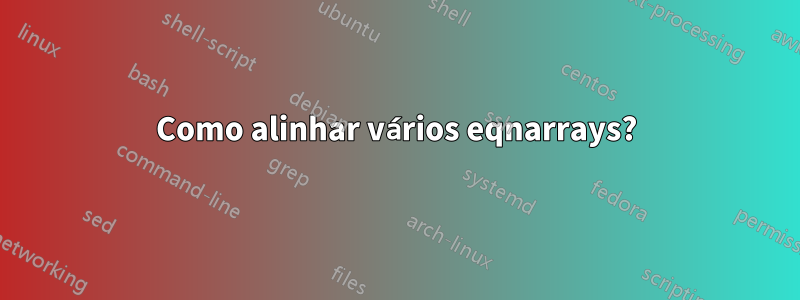
Tentei criar 2 eqnarrays, mas as equações nesses 2 eqnarrays não se alinham. Aqui está o código:
\documentclass{article}
\usepackage[fleqn]{amsmath}
\usepackage{txfonts}
\begin{document}
\begin{eqnarray}
\label{eq1}
&& diag\frac{\partial P}{\partial \theta}=
diag(-diag(V)[Gdiag(V)\sin(Abus)^{T}-Bdiag(V)cos(Abus)^{T}]
\nonumber\\
&& -diag(V).^{2}diag(diag(B)))) \\
\label{eq2}
&& nondiag\frac{\partial P}{\partial \theta}=
VV^{T}.* G .* \sin(Abus) -VV^{T}.*B .* \cos(Abus)
\end{eqnarray}
Replace the diagnol elements of the (\ref{eq2}) with the elements of the
(\ref{eq1}), we will get the complete $\partial P/\partial \theta$
\begin{eqnarray}
\label{eq3}
&& diag\frac{\partial P}{\partial V}=
diag(Gdiag(V)\cos(Abus)^{T}+Bdiag(V)sin(Abus)^{T}
\nonumber\\
&& +diag(V)diag(diag(G)))) \\
\label{eq4}
&& nondiag\frac{\partial P}{\partial V}=
diag(V)G .* \cos(Abus) + diag(V)B .* \sin(Abus)
\end{eqnarray}
Replace the diagnol elements of the (\ref{eq4}) with the elements of the
(\ref{eq3}), we will get the complete $\partial P/\partial V$
\end{document}
E o resultado é:
 podemos ver que as posições iniciais da equação (1),(2) e da equação (3),(4) são diferentes. Como posso resolver esse problema? Obrigado.
podemos ver que as posições iniciais da equação (1),(2) e da equação (3),(4) são diferentes. Como posso resolver esse problema? Obrigado.
Responder1
Substituir eqnarraypelo alignresultado não está perfeitamente alinhado, mas parece que está e acho melhor do que com eqnarray.
Seguindo a sugestão de Ian diage nondiagsão declarados operadores matemáticos. Também os tamanhos dos parênteses foram ajustados.
Após o comentário do Mico, um novo comando dotstarfoi declarado. Não está claro para mim o que isso faz.
\documentclass{article}
\usepackage[fleqn]{amsmath}
\usepackage{txfonts}
\DeclareMathOperator{\diag}{diag}
\DeclareMathOperator{\nondiag}{nondiag}
\newcommand\dotstar{\mathbin{.*}}
\begin{document}
\begin{align}
\label{eq1}
\diag\frac{\partial P}{\partial \theta} & =
\diag\left(-\diag(V)\left[Gdiag(V)\sin(Abus)^{T}-B\diag(V)cos(Abus)^{T}\right]\right.
\nonumber\\
&\quad \left.-\diag(V).^{2}\diag\left(\diag(B)\right)\right) \\
\label{eq2}
\nondiag\frac{\partial P}{\partial \theta} & =
VV^{T}\dotstar G\dotstar\sin(Abus)-VV^{T}\dotstar B\dotstar\cos(Abus)
\end{align}
Replace the diagnol elements of the (\ref{eq2}) with the elements of the
(\ref{eq1}), we will get the complete $\partial P/\partial \theta$
\begin{align}
\label{eq3}
\diag\frac{\partial P}{\partial V} & =
\diag\left(G\diag(V)\cos(Abus)^{T}+B\diag(V)sin(Abus)^{T}\right.
\nonumber\\
&\quad +\Bigl.\diag(V)\diag\left(\diag(G)\right)\Bigr) \\
\label{eq4}
\nondiag\frac{\partial P}{\partial V}&=
\diag(V)G\dotstar\cos(Abus) + \diag(V)B\dotstar\sin(Abus)
\end{align}
Replace the diagnol elements of the (\ref{eq4}) with the elements of the
(\ref{eq3}), we will get the complete $\partial P/\partial V$
\end{document}

Mas se você quiser que todas as equações estejam perfeitamente alinhadas, insira o parágrafo do meio dentro de um \intertextcomando.
\documentclass{article}
\usepackage[fleqn]{amsmath}
\usepackage{txfonts}
\DeclareMathOperator{\diag}{diag}
\DeclareMathOperator{\nondiag}{nondiag}
\newcommand\dotstar{\mathbin{.*}}
\begin{document}
\begin{align}
\label{eq1}
\diag\frac{\partial P}{\partial \theta} & =
\diag\left(-\diag(V)\left[Gdiag(V)\sin(Abus)^{T}-B\diag(V)cos(Abus)^{T}\right]\right.
\nonumber\\
&\quad \left.-\diag(V).^{2}\diag\left(\diag(B)\right)\right) \\
\label{eq2}
\nondiag\frac{\partial P}{\partial \theta} & =
VV^{T}\dotstar G\dotstar\sin(Abus)-VV^{T}\dotstar B\dotstar\cos(Abus)
%\end{align}
\intertext{Replace the diagnol elements of the (\ref{eq2}) with the elements of the
(\ref{eq1}), we will get the complete $\partial P/\partial \theta$}
%\begin{align}
\label{eq3}
\diag\frac{\partial P}{\partial V} & =
\diag\left(G\diag(V)\cos(Abus)^{T}+B\diag(V)sin(Abus)^{T}\right.
\nonumber\\
&\quad +\Bigl.\diag(V)\diag\left(\diag(G)\right)\Bigr) \\
\label{eq4}
\nondiag\frac{\partial P}{\partial V}&=
\diag(V)G\dotstar\cos(Abus) + \diag(V)B\dotstar\sin(Abus)
\end{align}
Replace the diagnol elements of the (\ref{eq4}) with the elements of the
(\ref{eq3}), we will get the complete $\partial P/\partial V$
\end{document}

Responder2
Nunca use eqnarray(vejaeqnarray vs alinhar)
Aqui a combinação de aligncom splitparece ser a melhor maneira de resolver o problema.
\documentclass{article}
\usepackage{mathtools}
\usepackage{newtxtext,newtxmath}
\DeclareMathOperator{\diag}{diag}
\DeclareMathOperator{\nondiag}{nondiag}
\newcommand{\dotstar}{\mathbin{.{*}}}
\newcommand{\Abus}{\mathit{Abus}}
\begin{document}
\begin{align}
\begin{split}
\diag\frac{\partial P}{\partial \theta} & =
\diag\bigl(-\diag(V)[G \diag(V)\sin(\Abus)^{T}-B\diag(V)\cos(\Abus)^{T}]\\
&\qquad -\diag(V)^{2}\diag(\diag(B))\bigr)
\end{split}
\label{eq1} \\
\nondiag\frac{\partial P}{\partial \theta} & =
VV^{T}\dotstar G\dotstar \sin(\Abus)-VV^{T}\dotstar B\cos(\Abus)
\label{eq2}\\
\intertext{%
By replacing the diagonal elements of the (\ref{eq2}) with the elements of
equation~\eqref{eq1}, we will get the complete $\partial P/\partial \theta$}
\begin{split}
\diag\frac{\partial P}{\partial V} & =
\diag\bigl(G\diag(V)\cos(\Abus)^{T}+B\diag(V)\sin(\Abus)^{T} \\
&\qquad +\diag(V)\diag(\diag(G))\bigr)
\end{split}
\label{eq3}\\
\nondiag\frac{\partial P}{\partial V}&=
\diag(V)G\dotstar \cos(\Abus) + \diag(V)B\dotstar \sin(\Abus)
\label{eq4}
\end{align}
By replacing the diagonal elements of equation~\eqref{eq4} with the elements of
equation~\eqref{eq3}, we will get the complete $\partial P/\partial V$
\end{document}
Substituí txfontspor newtxtexte newtxmath(as fontes matemáticas são melhores e os pacotes são mantidos ativamente).
Se você adicionar a tbtagsopção à amsmathequação, o número ficará alinhado com a linha inferior das splitpeças.
Eu removi tudo \lefte \rightisso não serviu para nada (eles apenas adicionaram espaço horizontal indesejado). \bigSão necessários apenas alguns pares.

Responder3
Usar intertexto em um ambiente de alinhamento obtém o alinhamento:
\documentclass{article}
\usepackage[fleqn]{amsmath}
\usepackage{txfonts}
\begin{document}
\begin{align}
\label{eq1}
& diag\frac{\partial P}{\partial \theta}=
diag(-diag(V)[Gdiag(V)\sin(Abus)^{T}-Bdiag(V)cos(Abus)^{T}]
\nonumber\\
& -diag(V).^{2}diag(diag(B)))) \\
\label{eq2}
& nondiag\frac{\partial P}{\partial \theta}=
VV^{T}.* G .* \sin(Abus) -VV^{T}.*B .* \cos(Abus)
\intertext{Replace the diagnol elements of the (\ref{eq2}) with the elements of the
(\ref{eq1}), we will get the complete $\partial P/\partial \theta$}
\label{eq3}
&diag\frac{\partial P}{\partial V}=
diag(Gdiag(V)\cos(Abus)^{T}+Bdiag(V)sin(Abus)^{T}
\nonumber\\
& +diag(V)diag(diag(G)))) \\
\label{eq4}
& nondiag\frac{\partial P}{\partial V}=
diag(V)G .* \cos(Abus) + diag(V)B .* \sin(Abus)
\end{align}
Replace the diagnol elements of the (\ref{eq4}) with the elements of the
(\ref{eq3}), we will get the complete $\partial P/\partial V$
\end{document}


